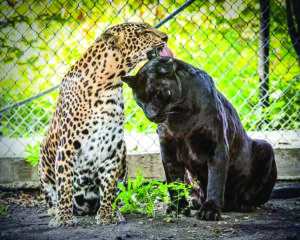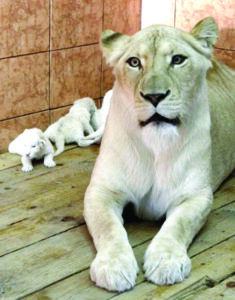By Dr. Beth Leermakres
As you watch your cat stalk a toy mouse with intense focus, it’s easy to see the big cat predator lurking in her. How similar are house cats to the big cats? Did your pet cat descend from a lion?

Photos courtesy of In Sync Exotics
Scientists examined the DNA of nearly 1000 wild and domestic cats living in different parts of the world. Their comparisons indicated that F. s. lybica (aka the African wildcat, a small cat) is the common ancestor of all domestic cats. African wildcat DNA — collected from remote deserts in Israel, the United Arab Emirates and Saudi Arabia — was virtually identical to the DNA of pet cats.
As a result of feline genetic research, experts now recognize 41 cat species worldwide. Scientists believe big cat and small cat lineages diverged from a common ancestor about 11.5 million years ago.
Although house cats didn’t descend from the big cats, they are related to them — especially tigers. A research study found that Amur tigers share 95.6 percent of their DNA with domestic cats.
Domestic cats share many characteristics and behaviors with their big-cat relatives:
They’re hunters. Anatomically, domestic and big cats have similar bodies — with powerful legs, flexible backs and sharp claws and teeth — that make them good hunters. All cats possess a natural hunting instinct that tells them the most successful ways to stalk and take down prey.
They sleep a lot. House cats spend most of their day sleeping, and so do their wild relatives — about 16-20 hours per day. Cats are most active between dusk and dawn. In the wild, the best time to hunt is when it’s dark. A big cat has better night vision than most of their prey, so they have the advantage in dim lighting. During the day, big cats sleep to conserve their energy.

They rub up against — and scratch — things. When your cat brushes against the sofa or your leg, she’s marking her territory — leaving behind scent markers that tell other cats to stay away. Big and domestic cats have scent glands all over their bodies, especially in their faces. House and big cats also scratch to mark their territory, leaving visible “no trespassing” signs.
Tigers stand on their back legs and scratch as high as possible on trees. According to Susan Bass, the director of public relations for Big Cat Rescue, young tigers who see claw marks 8-10 feet up on the tree trunk get the message: “This is how big I am. I can scratch way up here. If you can’t scratch higher, you’d better keep moving.” Protecting their territory is a matter of life or death for wild cats, so they take it very seriously.
They’re very vocal. Your cat meows, purrs and chirps, and the big cats talk too. Four “great” cats (lions, tigers, leopards and jaguars) have a different bone in their throat that allows them to roar. A lion’s roar can be heard by another lion that’s five miles away. Because lions live on wide open savannahs, they have to communicate over vast distances. The “lesser” cats (cougars, lynx and bobcats) can’t roar (and don’t need to), but they talk and purr.
They groom themselves a lot. Domestic cats spend 30-50 percent of their waking hours grooming themselves. Big cats constantly clean themselves, too. If a gazelle smells a predator, it will run away, so big cats remove as much of their scent as possible.
A cat’s tongue is covered in little backward-facing barbs (papillae) that help detangle knots and lift out debris from a cat’s fur. Those barbs also help big cats pull meat off the bones of their prey. Licking themselves helps big cats get rid of parasites and regulate their body temperature.
Licking spreads a natural oil that’s in their skin. That oil acts as an insulator, which keeps cats warm in the winter. In hot weather, spreading saliva all over their coats helps them stay cool. As the saliva evaporates, it releases heat from the body. Cats also sweat, but only through their paws.
They need the same meat-based diet. Big and small cats are carnivores who live on high protein diets and don’t need to eat fruits or vegetables. Lions don’t graze on grass, and plants aren’t a necessary part of a domestic cat’s nutrition. A cat’s digestive system is designed to digest prey, so the most species-appropriate diet for your house cat is raw meat.
They knead. The cute kneading behavior starts when cubs and kittens move their paws while nursing to stimulate milk flow. Whether that baby grows up to be a 10-pound tabby cat or a 600-pound tiger, making biscuits continues into adulthood, becoming a signal of relaxed contentment. Scientists don’t know why kneading persists, but they’ve seen big cats kneading in captivity and in the wild.
Whether they’re small or big, cats are all part of the same family. The next time your kitty wakes you up at 4 a.m. by leaping on and off your bed repeatedly, remember that she’s acting species-appropriately, if obnoxiously. If you’d like to observe big cats’ behavior up close, visit In Sync Exotics in Wylie (insyncexotics.org).
